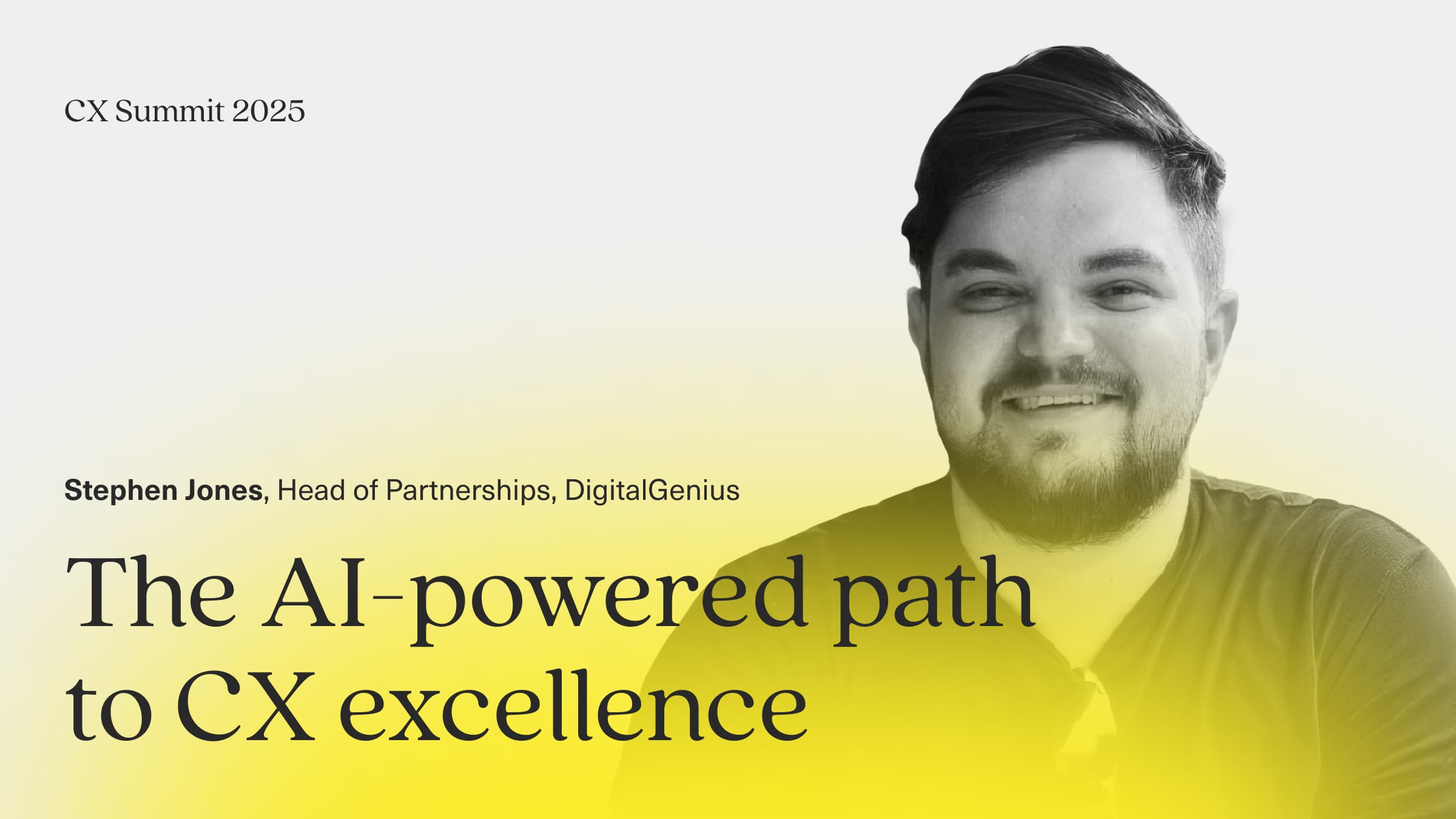Stephen Jones is the Head of Partnerships at DigitalGenius which provides customer service AI and automation for some of the world’s leading ecommerce and retail brands like Taylor Swift’s merch store, HOKA, and more.
Stephen spoke with Gabe at the CX Summit about tons of ways brands can use AI to enhance their customer experience and do it right. Dig in for some great case studies and tactics you can use!
This interview has been edited for clarity.
Gabe: AI is obviously the buzzword of the moment, but one of the questions people are grappling with is how to balance humans and automation in today’s ever-changing CX landscape. How do you think about that balance?
Stephen: That question is becoming increasingly important. AI is no longer a new concept—it is here. Brands are starting to ask, “What should AI be doing, and what should humans be doing?” At DigitalGenius, we actually own the trademark for “Human + AI” in the UK, which surprises people for an AI company.
We genuinely believe that humans will always play a critical role in customer experience. The service you deliver can make or break a brand, and anyone interacting with customers is influencing that experience, whether human or machine.
Gabe: Totally. I think the idea that humans are being fully replaced is unrealistic—at least for now. So how do leaders introduce AI to their teams in a way that feels empowering, rather than intimidating?
Stephen: That is a huge one for our clients—especially those with large teams. We always frame AI implementation around improving the customer experience, not just cutting costs. In fact, most of our clients are not using AI primarily for cost savings—it is about better CX.
Customers will cut ties with a brand after just one bad experience. That is huge. And I think we have all done that ourselves.
Gabe: I think we have all had that moment where one poor experience makes us walk away.
Stephen: Exactly. And different brands handle sensitive scenarios differently, which is key. For example, we work with Pure Pet Food in the UK, a dog food subscription brand. One very sensitive moment is when a customer cancels because their dog has passed away.
In that case, speed is more important than empathy. The worst thing would be accidentally sending more dog food afterward. So they choose to automate those moments to make sure it is handled immediately. Empathy is still there—maybe via generative AI—but the priority is fast resolution.
Contrast that with Charles Tyrwhitt, a formalwear retailer. Customers often contact them before weddings or funerals. In those situations, the parcel is not going to move any faster, so they prioritize empathy over speed and make sure those messages go to a human. The customer just wants to feel heard.
Gabe: Those are great examples of how nuanced this can be. So when you think about improving CX with AI, what is one area you think brands should focus on?
Stephen: I think the big one is recognizing that support agents do not just answer questions—they take action. They are working across 15 to 20 tools every day. Our client On Running reduced their wait time by 93% and handled 250% more customer conversations with just 10% more headcount.
How? They connected AI to all their tools—shipping portals, subscriptions, email marketing, and more. The more access your automation has to data and actions, the better your AI performs. That is true for humans, and it is just as true for AI.
Gabe: So true. You need data and system access to do anything meaningful whether you are human or machine. Are there any standout brands that you think are doing this really well?
Stephen: Yes, one that comes to mind is Butternut Box, a pet food subscription brand. They have been able to save 30% of canceled subscriptions by responding differently depending on why someone canceled.
If you and I both cancel for different reasons, we should not get the same response. They have automated logic around that—some cancellations are handled automatically, others are not. And it works. Customers who are retained in that way go on to order three more times on average.
Gabe: That is a great example of personalized CX at scale. One thing I hear a lot right now is that the market is saturated with AI vendors. Some leaders are saying, “I think I am going to wait until Gen 2—this is all too noisy.” What would you say to someone who is hesitant to jump in?
Stephen: I hear that a lot, especially from luxury brands. They are very protective of their tone of voice and promises to customers. My advice: start small. Be selective about use cases. You do not have to automate everything.
One good starting point is proactive support. A lot of CX leaders say they wish their agents were doing more outbound work—checking in on orders, asking about recent experiences, that sort of thing. AI makes that possible. For example, Clarins uses AI primarily for proactive outreach. Their customers care about speed and convenience, not necessarily whether the support is from a person or AI. They just want it to be accurate and fast.
Gabe: Yes! That proactive angle is so powerful but so hard to pull off. Sounds like Clarins has figured it out.
Stephen: Exactly. Another example is Porto’s Bakery. They use AI to proactively identify when an order might be lost in transit. If a package is stuck for more than a few days, the AI automatically reaches out to the customer and offers a refund or replacement. That is not something human agents could feasibly do at scale.
One more: a customer recently posted a handwritten note they received from a nutrition brand. They have thousands of conversations per month—there is no way they could write that note unless a large percentage of conversations were already automated. Freeing up time lets teams do those meaningful, personal touches.
Gabe: That is a great point. Proactive service and human touches are only possible when the day-to-day is automated. I think that is a helpful mindset shift—from “AI replaces humans” to “AI empowers humans to do higher-impact work.”
Stephen, this has been a great conversation. As we wrap, any final thoughts for CX leaders who might be feeling overwhelmed or uncertain?
Stephen: There is a lot to think about, but it does not have to be all at once. The key takeaway: bad chatbots usually exist because they only try to answer questions. But support teams do much more than that—they take actions across your tech stack.
If your AI does not have access to those same systems—subscriptions, shipping, CRM—it will always have to hand things off to a human. You will get fast first-response times, but not faster resolution or lower backlog.
If you want AI to handle 60%, 70%, even 80% of conversations end-to-end, give it the tools it needs. Choose a tech stack with open APIs and make integration a priority. That is how you unlock real results.
Closing thoughts
Stephen Jones of DigitalGenius reminds us that AI is not here to replace humans—it is here to empower them. The future of CX is a thoughtful blend of automation and empathy, where technology handles the repetitive so humans can focus on what matters most. To deliver standout experiences, CX leaders must be strategic in how they deploy AI. Four key takeaways:
- Use AI to automate actions, not just answers
- Start small with specific, high-impact use cases
- Prioritize proactive, personalized outreach
- Ensure AI has access to the same tools as your agents
Ready to take the next step in your brand’s customer experience with AI? Check out our guide on how to best leverage AI Agents so you can get ready to implement them for your brand.
Then, see how Kustomer’s human-in-the-loop AI tools can help you scale effectively.




